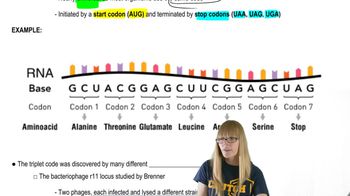Table of contents
- 1. Introduction to Genetics51m
- 2. Mendel's Laws of Inheritance3h 37m
- 3. Extensions to Mendelian Inheritance2h 41m
- 4. Genetic Mapping and Linkage2h 28m
- 5. Genetics of Bacteria and Viruses1h 21m
- 6. Chromosomal Variation1h 48m
- 7. DNA and Chromosome Structure56m
- 8. DNA Replication1h 10m
- 9. Mitosis and Meiosis1h 34m
- 10. Transcription1h 0m
- 11. Translation58m
- 12. Gene Regulation in Prokaryotes1h 19m
- 13. Gene Regulation in Eukaryotes44m
- 14. Genetic Control of Development44m
- 15. Genomes and Genomics1h 50m
- 16. Transposable Elements47m
- 17. Mutation, Repair, and Recombination1h 6m
- 18. Molecular Genetic Tools19m
- 19. Cancer Genetics29m
- 20. Quantitative Genetics1h 26m
- 21. Population Genetics50m
- 22. Evolutionary Genetics29m
11. Translation
The Genetic Code
Problem 29e
Textbook Question
Shown here are the amino acid sequences of the wild-type and three mutant forms of a short protein.
___________________________________________________
Wild-type: Met-Trp-Tyr-Arg-Gly-Ser-Pro-Thr
Mutant 1: Met-Trp
Mutant 2: Met-Trp-His-Arg-Gly-Ser-Pro-Thr
Mutant 3: Met-Cys-Ile-Val-Val-Val-Gln-His _
Use this information to answer the following questions:
For each mutant protein, determine the specific ribonucleotide change that led to its synthesis.
 Verified step by step guidance
Verified step by step guidance1
Identify the codons for each amino acid in the wild-type sequence: Met (AUG), Trp (UGG), Tyr (UAU or UAC), Arg (CGU, CGC, CGA, CGG, AGA, AGG), Gly (GGU, GGC, GGA, GGG), Ser (UCU, UCC, UCA, UCG, AGU, AGC), Pro (CCU, CCC, CCA, CCG), Thr (ACU, ACC, ACA, ACG).
Compare the wild-type sequence with Mutant 1: Met-Trp. Notice that the sequence stops after Trp, suggesting a premature stop codon. Identify possible stop codons (UAA, UAG, UGA) that could replace the Tyr codon (UAU or UAC).
Compare the wild-type sequence with Mutant 2: Met-Trp-His-Arg-Gly-Ser-Pro-Thr. Notice the addition of His (CAU or CAC) after Trp. Determine which nucleotide change in the Tyr codon (UAU or UAC) could result in His.
Compare the wild-type sequence with Mutant 3: Met-Cys-Ile-Val-Val-Val-Gln-His. Notice the complete change in sequence after Met. Identify possible nucleotide changes in the Trp codon (UGG) that could result in Cys (UGU or UGC) and continue to identify changes for the subsequent amino acids.
Summarize the nucleotide changes for each mutant: Mutant 1 involves a stop codon, Mutant 2 involves a single nucleotide change for His, and Mutant 3 involves multiple changes leading to a different sequence.
Recommended similar problem, with video answer:
 Verified Solution
Verified SolutionThis video solution was recommended by our tutors as helpful for the problem above
Video duration:
2mPlay a video:
Was this helpful?
Key Concepts
Here are the essential concepts you must grasp in order to answer the question correctly.
Amino Acid Sequence
The amino acid sequence of a protein is determined by the order of nucleotides in the corresponding mRNA, which is transcribed from DNA. Each amino acid is encoded by a set of three nucleotides, known as a codon. Understanding the relationship between the amino acid sequence and the genetic code is essential for identifying mutations and their effects on protein structure and function.
Recommended video:
Guided course

Sequencing Difficulties
Mutations
Mutations are changes in the nucleotide sequence of DNA that can lead to alterations in the amino acid sequence of proteins. These changes can be classified as substitutions, insertions, or deletions. Analyzing the specific type of mutation in the context of the provided amino acid sequences is crucial for determining how each mutant protein differs from the wild-type.
Recommended video:
Guided course

Mutations and Phenotypes
Ribonucleotide Changes
Ribonucleotide changes refer to alterations in the RNA sequence that can result from mutations in the DNA. These changes can affect the mRNA codons, leading to different amino acids being incorporated into the protein. Identifying the specific ribonucleotide changes that correspond to each mutant protein is key to understanding the genetic basis of the observed phenotypic differences.
Recommended video:
Guided course

New Alleles and Migration

 11:43m
11:43mWatch next
Master The Genetic Code with a bite sized video explanation from Kylia Goodner
Start learningRelated Videos
Related Practice


